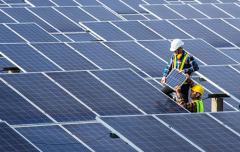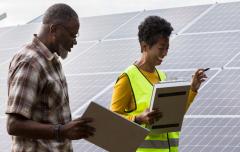Editor's pick: Energizing Africa’s health care - how electricity helps make people better
By Jon Heggie
This article was first published on National Geographic
Health care is increasingly driven by electricity, which is a big problem in Africa, where energy is often unreliable or even inaccessible.
In a brightly lit hospital room, the gentle hum of medical equipment is punctuated by the persistent beep of a heart monitor and the steady beat of an oxygen pump. It’s a recognizable scene as medical professionals and technology work together to make a patient better. Most people would agree that health care is a fundamental human right, and that everyone should have access to whatever health services needed, when and where they are needed. This belief is reflected in UN Sustainable Development Goal 3 that aims “to ensure healthy lives and promote well-being for all at all ages.” However, fewer than half of Africans have access to modern health facilities, and in remote areas, a visit from a mobile medical unit could mean more than a month’s wait, with the alternative being a long journey to the nearest city—often by foot. Health care systems throughout Africa remain inadequate, and while every country has its own specific difficulties, one basic challenge across the continent is limited access to electricity.
In high-income countries, hospitals are among the largest commercial consumers of electricity, relying on power for everything from water supply, temperature control, lighting, and ventilation to a huge range of clinical equipment. In contrast, many hospitals and clinics across Africa don’t have access to reliable electricity―if they even have any access at all. This leads to serious problems, including the spoiling of medicines and the inability to use essential medical and diagnostic devices; even the lack of basic lighting and communications can complicate treatments—especially emergency procedures. Lack of electricity limits working hours and inhibits the deployment of medical technology; recent reports have highlighted the importance of technology in health care and its potential to transform how health care is delivered in Africa. But most technology requires a reliable source of electricity, and that is often lacking.
The problem lies with an underdeveloped energy industry that struggles with both power generation and distribution. The electricity supply through national networks regularly fails to keep pace with demand—some countries in Africa experience power outages as much as 50% of the time. This widespread inability to access electricity from the grid forces many hospitals and clinics to rely instead on diesel-powered generators. These generators are often unreliable and expensive to run, as well as being bad for the environment. Back-up generators can’t prevent the sudden blackouts that damage delicate medical machinery or disrupt medical procedures and endanger patients’ lives. Wherever you are on the planet, a source of reliable electricity is fundamental to providing the effective health care we consider a basic right—but there is a solution.
Africa possesses huge potential for generating off-grid renewable energy through solar, wind, and even hydro power. And costs associated with installing these sustainable power sources continue to fall; solar panel prices have dropped around 80 percent over the last decade. Renewable energy offers medical centers efficient, low-cost, reliable, and independent sources of electricity that have the potential to significantly expand and improve health care access and delivery where power is a problem—especially in remote rural areas. Small photovoltaic (PV) solar power systems are already widely in use across Africa, and help health workers provide care and diagnoses, charge cell phones for communication, and safeguard vaccines and other medications in portable cooler units. Larger PV solar arrays are used to power a range of essential devices, including lights, water pumps, phones, and refrigerators, as well as laboratory equipment and a host of vital medical devices.
Even so, with many health care facilities underfunded and unable to afford set-up costs for renewable energy, there have been calls for public-private initiatives through which multinational companies that extract resources in Africa would support local communities by funding the essentials of health care. Such projects could include electricity. One example is Enel Green Power’s (EGP) work with St. Luke hospital in Wolisso, Ethiopia. Located about 110 kilometers southwest of Addis Ababa, the country’s capital, Wolisso is home to more than 60,000 people, and the hospital here is an important health care center serving a patient base of over a million people. Despite its importance to the community, St. Luke suffered frequent power outages, forcing it to use diesel generators to ensure a consistent power supply.
As a renewable energy company supporting Ethiopia’s sustainable power ambitions, EGP used its expertise to design and build an innovative solar hybrid system for St. Luke hospital. Made up of a photovoltaic plant and batteries, the sustainable system delivers as much as 320 kWh of electricity, and the plant is able to manage the flows of energy in real time to guarantee a constant power supply. This enables the hospital to provide more effective care for the roughly 79,000 outpatient visits, 15,000 hospitalizations, and 4,000 births that they handle every year. What’s more, the integration of solar power has resulted in cost savings―money that the hospital can now reinvest in health care services for the community. For Ethiopia, as for all of Africa, there is a powerful nexus between energy and health care: access to electricity is a key enabler of access to the modern health care that is our fundamental human right.
Photo credit: Enel




